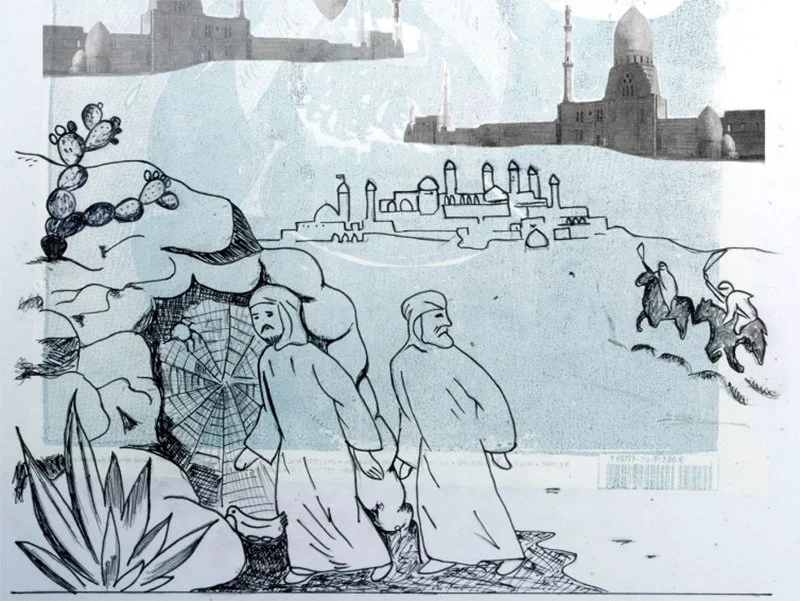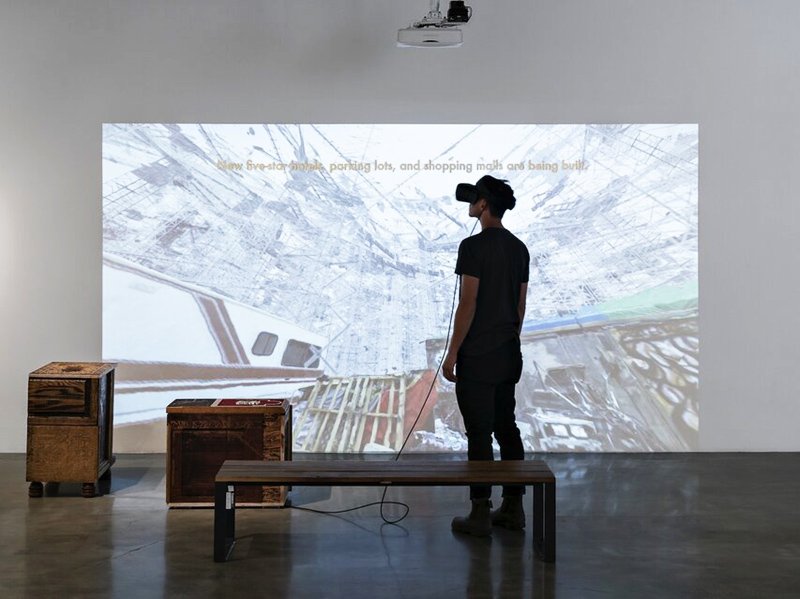Episode 43: Asma Kazmi, 5 Questions: A Critical Mass for the Visual Arts Podcast, 2021
Asma Kazmi is a research-based artist who combines virtual and material objects to explore simultaneity — a tug of more than one time and place. Her work involves long term engagement with cities, architecture, plants, animals, stones, and other matter to locate vestiges of relations forged by the legacies of colonialism and post-colonial contexts. Combining visual and textual detritus from western and non-western historical manuscripts, photographs, archival material, fragments of locations, and mixing them with her own fabulations, Kazmi tells intertwining stories about Islam, Muslim culture, complex trade routes, global flows of people and commodities, labor, colonial and indigenous knowledge systems, and interspecies entanglements.
Asma Kazmi, Fruit from Elsewhere & Other Works, The Gallery t2f, Karachi, 2021
In this artist talk Asma Kazmi will discuss her new work Fruit from Elsewhere about the Mangifera Indica (Indian mango). She will also speak about other research-based art projects from the last five years.
Dissonant Matter: Talk with Guillermo Galindo, Asma Kazmi & Sugata Ray, Kala Art Institute, 2020
The installation unfolds with a rhizome-like logic—documenting South Asian and colonial representations of the fruit, hearsay and scientific reports about the use of mango in pigment extraction, and the artist’s longing for the fruit in known and unknown places. These intertwining stories ask questions about complex trade routes, global flow of people and commodities, colonial and indigenous knowledge systems, and interspecies entanglements.
Guillermo Galindo and Asma Kazmi, Dissonant Matter (catalog), including essay by Sugata Ray, Vegetal Aesthetics in the Anthropocene, Kala Art Institute, 2020
Mangoes—allegedly the king of fruits—loom large in Asma Kazmi’s works. If (Mughal emperor) Jahangir had described mangoes as his “favorite” fruit in his memoirs, Kazmi traces another history of the global consumption of the fruit through the movement of migrant laborers across the Indian Ocean. At the same time, the leaf of the mango plant transmutes into Indian yellow pigment—the luminous color that animated the palette of British artists such as JMW Turner via cow urine—in Kazmi’s sculpture and drawings. In process, the materiality of paint and traces of plant-life merge into each other to generate a vegetal aesthetics of the much-coveted Indian yellow that short-circuits Europe’s imperial conceit.
Pamela Reynolds, 'The City Inside Us' Exhibition Takes On The Hidden Narrative Of Places In Transition, WBUR, 2019
(Asma Kazmi) investigates the idea of memory and place… interweaving virtual reality objects with drawings, text and video and sculptures. She is most concerned with how cities change, pushing certain people out while welcoming others in…. “It's not that I'm lamenting change, but I'm critiquing how the change is happening in an unconsidered way, where lots of people have been marginalized in the process.”
Leila Weefur, Percussive Ritual in Asma Kazmi’s City of Migrants, The Wattis Institute, 2018
Kazmi’s work, predominantly time-based media and VR, is concerned with interaction and collision. She situates her subjects to negotiate their proximities to one another, highlighting the subtleties that rest in the interstices of interaction, in moments when both time and silence are personified.
Asma Kazmi, Deep Dive or the Limits of Immersion: Curatorial Foreword, 2018
This is the contradiction or the strength of VR/AR: that it creates what Borges might call the garden of forking paths—a structure that foregrounds the simultaneity of all possible narrative and experiential threads. The artworks included in Deep Dive Or the Limits of Immersion allow for a contrapuntal and critical read of VR/AR by interweaving multiple visual perspectives, synthesized media, non-linear narrative forms, interactivity with no logic or rules of engagement, non-photoreal and deconstructed formal vocabularies, a low-res aesthetic, and bulky headgear that keeps the viewer tethered to the computer and heightens their awareness of their bodies.
Sarah-Dawn Albani, Cranes and Cubes Catalog Essay, 2018
Asma Kazmi’s Cranes and Cubes is a hypnotic witnessing of a collision between dissonant temporalities and the complex belief systems animating them, as well as the long relationship between religion and commercialism. The whirring drone of construction sounds and a forest of cranes that signify the neoliberal urge for unfettered growth are the backdrop for the artist’s exploration of place, pilgrimage, time, memory, and a longing for meaning in a world driven by a manic desire for the new.
Asma Kazmi, Cranes and Cube and Some Other Works, Bay Area Conversations: The Arts of South Asia and its Diasporas Conference, Institute for South Asian Studies, UC Berkeley, 2018
My work is shaped by my experience as an immigrant to the United States, as a person shifting between multiple languages, identities, and locations. I have a research based process which allows me to imagine embodied relationships with subjects in various cultural contexts. I work between the US, India, Pakistan, Europe, and the Middle East to make works that are legible and relevant across cultures.
Santhi Kavuri-Bauer, The Parallax View: The Art of Envisioning the South Asian American Diaspora, South Asian Diaspora 10(1), 2017
The drawings in Palimpsest were created through a process of erasure that calls attention to how signs and symbols of Islam are resignified in the West, resulting in a skewed reality of their meaning…. “The final works are layered manuscripts where images are drawn and erased, and drawn over again to build a sequence of strata on paper. These layers chart a nonlinear, unwritten history of representation within Islam and also consider depictions of Muslims and Muslim culture by others.” From this point of view, Kazmi asks her viewers to recognise both the historical reality of Islam’s representation of Muhammad but also, and more importantly, the persistence of Orientalist desire in the West to see Muslims as Other, thereby subjecting them to potential physical and psychic violence.
Berkeley Center for New Media, Interview with Asma Kazmi, 2017
The experience of being an immigrant–as a person shifting between multiple languages, ethnicities, and identities–came to define the themes in my art practice. As a recent transplant to the U.S., I had a heightened sense of awareness of my difference here and this position of being a participant observer felt like a ripe place to generate ideas from.
Asma Kazmi, Writings of Manto in English Clothes, BootPrint 2(2), 2008
Writing about his translation of Victor Hugo, Manto explained that he had dressed Hugo’s masterpiece in Urdu clothes. Mootni and Khushai, two powerful short stories of Manto, feel ill at ease in English clothes. Perhaps this is so because this work is a product of the postcolonial examination of cultural decay in South Asia.… I chose Mootni because of its raw and vivid descriptions of human waste and degradation, serving as a metaphor for the corroding sociopolitical climate at the time of partition of India.
Paul Ha, Art Stars: Five of the St. Louis’ Buzziest Visual Artists to Keep on Your Radar, Alivemag.com, 2008
(Asma Kazmi’s) most recent work is a touching and poignant performance and video piece called Translation of a Conversation with My Mother (2007). In the piece, Kazmi reveals the difficulty of language and generation gaps as her and two others translate the artist’s Pakistani mother in real time.
All content copyright Asma Kazmi or original author or publisher. Provided for cultural and educational purposes.












